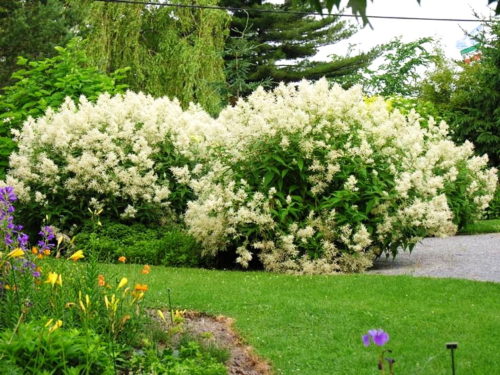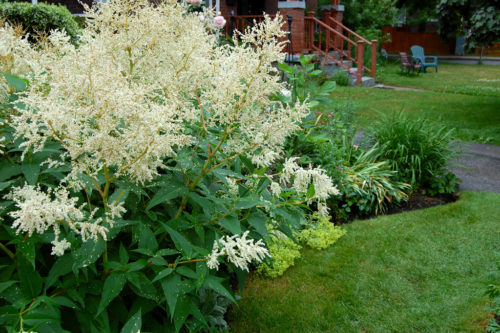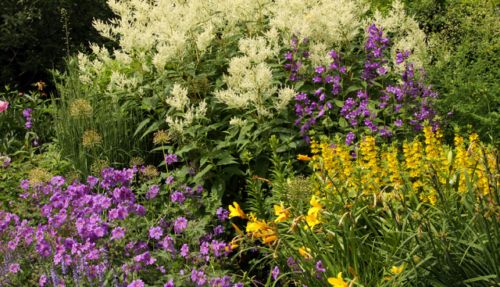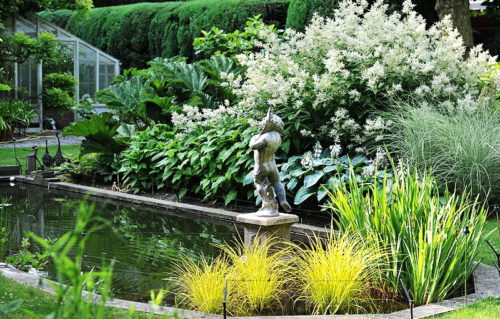Although the Highlander refers to the plants of the Buckwheat family, 20 species of 300 are used for cultural flower growing. This refers to the Highlander Changeable. He is majestically towers over the rest of the plant in the garden. But, despite his height of 2 meters, the inflorescences of the Highlander resemble an air cloud from white flowers with a honey smell. Plant blooms for more than 2 months. Even after this period, dried inflorescences with purple shoots decorate a plot to late autumn. So that the Highlander Changing becomes decorating your garden, it is important to take into account not only the conditions for planting culture, but also the rules of care.
Highlander Changeable - Description of the form
- Among the many types of this plant should determine its type. Highlander changeable belongs to herbaceous plants, no matter how strange it sounds. Used for landing in open soil.
- Mountain Highland is Eastern Asia. It grows in the form of a large bush with a total height of about 2 meters and is used in flower growing as a perennial plant.
- Inflorescences are of large size, with many small colors on belties from white to a light pink shade. The fragrance is very bright and reminds the smell of honey. Highlanders blooms from July and until the end of August, and with warm climates, flowers remain fresh until mid-September. After flowering, they dry, without changing the color. You can also provide re-flowering plants in the season if you cut dry inflorescences. The side processes are gaining strength, and begin to bloom.
- Despite the large volume of blooming clouds, they do not need a garter. Massive stems wide at the base and branches on the top tightly keep inflorescences. Inside the branch hollow with a massive flesh. After the end of the flowering period, shoots are painted in purple color. So the garden you will have decorated until late autumn.
- The root system is quite powerful, although it is not deep into the ground (about 30-50 cm.). Strong roots are able to keep the bulk bush and grow in Earth almost under the entire surface of the plant, not only near the stem.
- The leaves, in contrast to most other types of mountain, cover the stem throughout its length. Have an extended form, from which the bush acquires volume.
- The view of the potable potato can easily determine in his photo. Large bushes with a white cloud that stand out among other flower crops in the garden.
Highlander changeable - reproduction
- It is impossible to grow this type of plant from seed. Although for the growing majority of other varieties of this culture are used. Gardeners spread the pots of volatile with cuttings or root offspring.
- Use one way or another way of reproduction depends on the season. So in the spring period, before the formation of inflorescences, it is customary to transplant siblings. Since the root system of young shoots has not yet gained strength, this option for breeding the plant is most effective.
- This type of highlander is so unpretentious that it can be divorced with cuttings. This method is used only in the summer since the flowering of the plant and before fading the inflorescences. But the drains are prepared in a special way, only then they can be replaced as a separate plant.
Highlander changeable - landing
- For the primary planting of the culture, choose a solar place on the garden plot. Slightly shady space on the flower bed is suitable for the growth of the potstimate.
- A special kind of soil for plant landing is not required. It is preferable that the soil is fertile and humid with low acidity. For the fertilizer of the soil, it is possible to use compost with the addition of ash to increase the alkaline medium of the soil.
- As described above, the reproduction of the plant takes place in two seasons: Spring and Summer. The easiest and fast transplant option is to use root offspring. Also, this transplant option has another name "division".
- Sleeping the gentle of volatile is a fully formed plant with its separate root system. It is fully adapted to growth on the ground, so the adaptation period passes quickly.
- A new plant should be separated from the maternal stem with a sharp knife and immediately transplanted on the prepared primer (switched and fertilized). Since the Highlander Sunconium Plant, the first 2-3 days of the offspring must be shaped for rapid rooting.
- The landing should be taken shallow, so that the roots of escapes do not charge and be able to saturate oxygen. At this stage, the plant needs regular irrigation, but not excessive.
- For reproduction with cuttings, you first need to take away young and healthy shoots. It is necessary to do this since spring. Take a ribbon on it to easily find the necessary stem among foliage.
- Fort the stem to the ground, hurt it and moisture the soil. Make sure that the plot with a cushion does not climb, otherwise the roots will start rot. When new sprouts appear on the surface, overcover the stem with a metal ring. This will reduce food from the maternal bush.
- A month before the planned transplant, completely separate the cuttings from the main plant, but do not dig. After rooting the plant, it is transplanted to another site.
- Highlander changeable well takes on to a new place, the adaptation period passes quickly. Root system develops intensively. As a result, after a year of the year, the bush should be limited in further reproduction, as well as dig up or transplant lateral processes.
- Perennial plants have the ability to grow. If you do not delete young shoots from the roots, the bush will acquire a shapeless volume. In addition, they will take care of the main part of the bush, and this will weaken his inflorescences.
- If after the transplantation plant dried up, do not rush to pull it out. Continue to water him and after a few days there will be new sprouts. A perennial plant can do without a transplant of about 10 years. Then you should land new shoots.
- Experienced gardeners argue that even from the smallest root can grow a full-fledged plant. If you decide to transfer the Highlander to another site or withdraw it at all, more carefully leakage the soil at the place of its growth.
Highlander Changeable - Plant Care
- In the care of Highlanders is unpretentious. Watering are moderate depending on the nature of the plant growing. But in particularly dry days it needs abundant irrigation, since the root system is in the upper layer of the soil and is unable to extract moisture from depth.
- If there is no full-fledged watering on such days, then the plant will be defeated by the attack. With timely humidification of the soil, the Highlander cannot be changed, and amazed by various pests, as it will affect the resistance to them.
- To facilitate the plant care, some gardeners resort to the mulching of the soil. An additional layer of peat helps to keep moisture in dry days and will not give me a bitch in rainy weather, which will avoid rotting roots.
- Crouching dried stems spend early spring, before the appearance of the kidneys. At the same time, it is customary to trim dry inflorescences, as the fall of dried flowers additionally decorate the plant. If necessary, root processes are digging to form the bush crown.
- Highlanders changeable well tolerate freezing, therefore it does not need additional shelter. Even if the winter is harsh and some stems will get out, the Highlander will quickly recover and give new sprouts in the spring.
- Before wintering, all stems are cut off, leaving leaves on them. The total height of each branch should not be less than 30 cm. From the Earth. But in the first two years of culture landing, young shoots should be hidden for the winter, since weak stems may die.
- In the period of abundant flowering, the soil should be done. For the mountaine, the humus is perfect, which must be added during irrigation. This is the only time the plant needs additional fertilizer.
- But at the same time, to reduce watering from the moment of start and before the end of the flowering of the plant. This is distinguished by Highlanders from most other garden crops.
- There is another feature of the Highlander - weeds are not growing under it. Therefore, in additional stinging, it does not need.
Highlander Changing in Garden Design
- Due to the large size of the bush culture can act as a hedge, which can cover unwanted areas in the garden or decorate small buildings. Moreover, the bush has a different height, which actively use landscape architects in formation of floral portion.
- Often choppy knotweed is grown to make a distinction in the garden areas. Since the plant may be separated from the main body portion of a small pond or pool.
- Tall stems look great solo on the grass or lawns, creating a shadow on them. Because of the bright honey flavor many gardeners planted near the mountaineer resting places or under the windows of the house.
- The same culture used to design the rear side beds. But keep in mind that the plant belongs to the invasive species. Many gardeners also called decorative knotweed weed. Growth requires adjustment of young shoots, otherwise they will hinder the growth of other colors.
- To contain abundant growth of plants gardeners recommend restrictions around the bush dig in at the desired distance from him. Protective baffles must be immersed to a depth of at least 30 cm. Or initially planted plant to a large capacity which is pre-dug. Otherwise year growth knotweed choppy be able to cover an area of \u200b\u200babout a couple of meters around.
- Choosing Highlander proximity to other plants, take into account the size of the bush and an abundance of greenery on it. Neighbors must match him in height and have a bright color. For example, in proximity to the volatile Highlander well will grow echinacea, grasses and ornamental species, all kinds of geranium.
- Just tender plants do not survive the changing neighborhood with the mountaineers. Even the young shoots from the parent bush can take away from other plants most of the nutrients and moisture. Therefore, when the cultivation of these crops should be the degree of its reproduction and spend time forming thickets.
Before you decide to landing mountaineer changeable in their area, carefully examine not only the right care for them, but also the growth characteristics of this type of culture. Highlander has many varieties that are radically different from each other.
Sakhalin knotweed look like a kind of mountaineer variability in breeding and care methods. On the similar features of its growth see in the video:
Learn about the main types of Highlander, which are often used in horticulture, you'll be able to video:



















 Start a discussion ...
Start a discussion ...